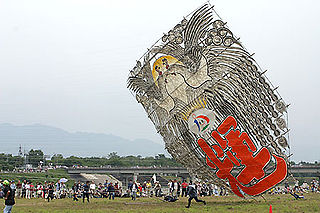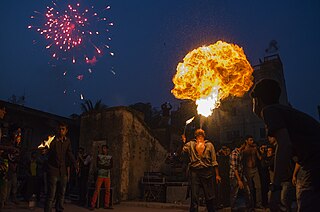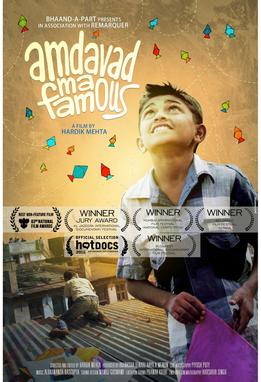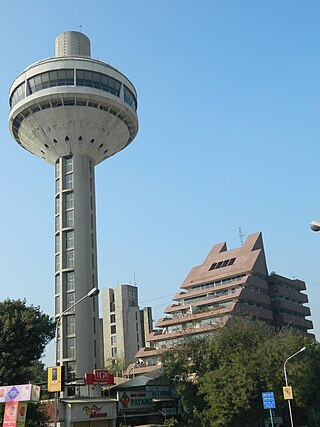
A kite is a tethered heavier-than-air or lighter-than-air craft with wing surfaces that react against the air to create lift and drag forces. A kite consists of wings, tethers and anchors. Kites often have a bridle and tail to guide the face of the kite so the wind can lift it. Some kite designs do not need a bridle; box kites can have a single attachment point. A kite may have fixed or moving anchors that can balance the kite. The name is derived from the kite, the hovering bird of prey.

Ahmedabad is the most populous city in the Indian state of Gujarat. It is the administrative headquarters of the Ahmedabad district and the seat of the Gujarat High Court. Ahmedabad's population of 5,570,585 makes it the fifth-most populous city in India, and the encompassing urban agglomeration population estimated at 6,357,693 is the seventh-most populous in India. Ahmedabad is located near the banks of the Sabarmati River, 25 km (16 mi) from the capital of Gujarat, Gandhinagar, also known as its twin city.

The Sabarmati river is one of the major west-flowing rivers in India. It originates in the Aravalli Range of the Udaipur District of Rajasthan and meets the Gulf of Khambhat of Arabian Sea after travelling 371 km (231 mi) in a south-westerly direction across Rajasthan and Gujarat. 48 km (30 mi) of the river length is in Rajasthan, while 323 km (201 mi) is in Gujarat.
Events in the year 2006 in the Republic of India.

Vasant Panchami, also rendered Vasanta Panchami and Saraswati Puja in honour of the Hindu goddess Saraswati, is a festival that marks the preparation for the arrival of spring. The festival is celebrated in Indian religions in different ways depending on the region. Vasant Panchami also marks the start of preparation for Holika and Holi, which take place forty days later. The Vasant Utsava (festival) on Panchami is celebrated forty days before spring, because any season's transition period is 40 days, and after that, the season comes into full bloom.

Manja is an abrasive string used to fly fighter kites, mainly in South Asian countries. Made when a cotton string is coated with powdered glass or a similar abrasive.

Sabarmati Riverfront is a waterfront being developed along the banks of Sabarmati river in Ahmedabad, India. Proposed in the 1960s, the construction began in 2005. Since 2012, under Phase 1, the waterfront is gradually opened to public as and when facilities are constructed and various facilities are actively under construction. The major objectives of project are environment improvement, social infrastructure and sustainable development. Phase 2 was approved in 2020.

According to the 2011 national census, the population of Ahmedabad was declared to be 7,214,225. This figure was only limited to the municipality region. The total population of the Ahmedabad Urban Agglomeration came to 7.2 million people. There were 886 females to every 1000 males in 2001. Now there are 904 women to 1000 men in 2011. Ahmedabad had a literacy rate of 79.89% in 2001 which rose to 89.62 percent in 2011. Out of this, male and female literacy are 93.96 and 84.81 percent as of 2011 census. According to the census for the ninth plan, there are 30737 rural families living in Ahmedabad. Out of those, 5.41% live below the poverty line. There are 439,843 people who live in slums in the city. The majority of residents of Ahmedabad are native Gujaratis and speak Gujarati. There is also a sizable population of Punjabis, Marathis, Tamils, Sindhis, Malayalis and Marwaris who bring in their native language and culture to the city. The government institutions and military base near the city also bring peoples from across India. The city's population has increased in a major way following increasing economic expansion and modernization.

Kalol is a city in Gandhinagar district in the Indian state of Gujarat, located alongside Gujarat State Highway 41 between the cities of Mehsana and Ahmedabad.

Vibrant Gujarat also referred to as Vibrant Gujarat Global Summit is a biennial investors' global business event that is held in the state of Gujarat, India. The event is aimed at bringing together business leaders, investors, corporations, thought leaders, policy and opinion makers; the summit is advertised as a platform to understand and explore business opportunities in Gujarat. The summit's primary objective is to promote Gujarat as an attractive investment destination and to facilitate partnerships and collaborations across different sectors. Summit began in 2003 and is now held every two years.
Pilvai is a village in Mehsana district in the state of Gujarat. Pilvai is located in Vijapur county and connected to Mehsana, Himatnagar, Gandhinagar and Ahmedabad by road. Ahmedabad international Airport is approximately 60 km from Pilvai. Pilvai has several educational institutes.

Gujarat is a state along the western coast of India. Its coastline of about 1,600 km (990 mi) is the longest in the country, most of which lies on the Kathiawar peninsula. Gujarat is the fifth-largest Indian state by area, covering some 196,024 km2 (75,685 sq mi); and the ninth-most populous state, with a population of 60.4 million. It is a popular tourist destination in the country and was visited by 19.5 million domestic tourists and 210 thousand international tourists in 2020.

Shakrain Festival is an annual Bengali celebration in Dhaka, Bangladesh, observed with the flying of kites. It occurs at the end of Poush, the ninth month of the Bengali calendar. This day is known as Poush Sangkranti.

Sabarmati Marathon was an annual marathon foot-race held in Ahmedabad. It was held in January-February months from 2010 to 2015. It attracted a large number of local as well as some foreign participants.

Manek Burj, also spelled Manek Buraj is the foundation bastion of Bhadra Fort in the old city of Ahmedabad, Gujarat, India. The Burj is associated with legendary saint Maneknath.

Hasmukh Chandulal Patel was an architect credited with making significant contributions to contemporary architecture in India in a career spanning over four decades in the latter half of 20th century. His works are held in high-regard alongside those of prominent Indian architects in the post-independence era like Achyut Kanvinde, Charles Correa, Anant Raje, B.V. Doshi and others.

Amdavad Ma Famous is a documentary film about kite flying festival in Ahmedabad, India. The film is directed by Hardik Mehta and produced by Akanksha Tewari and Arya A. Menon. It was filmed with help of cinematographer Piyush Puty and Harshbir Singh. The film received the National Film Award for Best Non-Feature Film at 63rd National Film Awards for 2015.
The Jivdaya Charitable Trust (JCT), headquartered at Ahmedabad in the Indian state of Gujarat, is a not for profit, non-governmental organisation which provides free medical care to unowned domestic animals and also runs a rehabilitation centre for wild birds and small mammals. Its main objective is to nurture injured animals back to health. It is located in the city centre.

Patang Hotel, officially Neelkanth Patang – The Revolving Restaurant, is a revolving restaurant located at Nehru Bridge corner on Ashram Road in Ahmedabad, Gujarat, India. Built in 1980–1984, 221 feet (67 m) above the ground, it is considered as the landmark of Ahmedabad.

Atal Pedestrian Bridge is a pedestrian triangular truss bridge at Sabarmati Riverfront on Sabarmati river in Ahmedabad, Gujarat, India. It has a design inspired by kites. Inaugurated in 2022, it is 300 metres (980 ft) long and 10 metres (33 ft) to 14 metres (46 ft) wide.



















